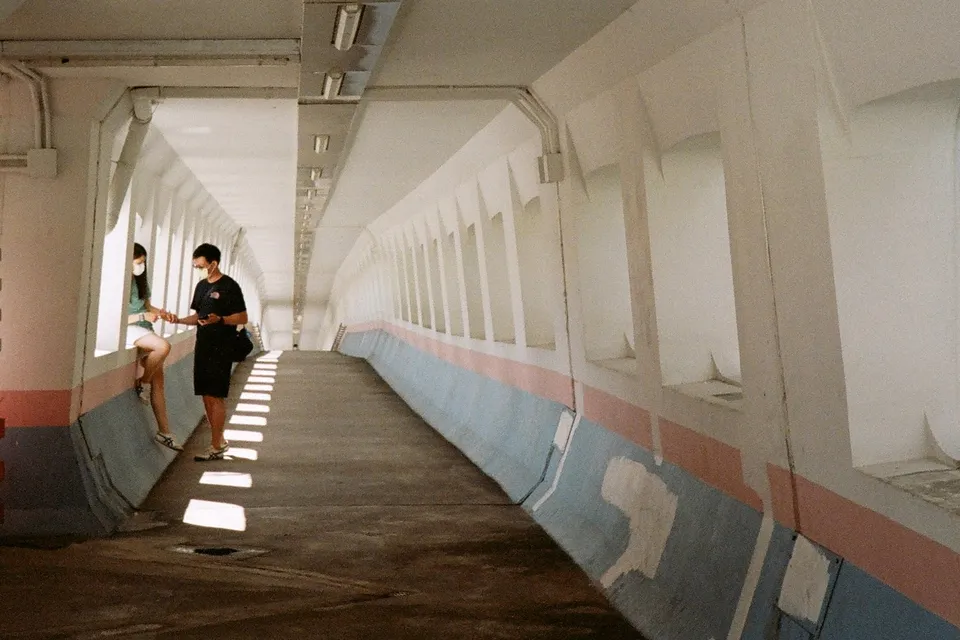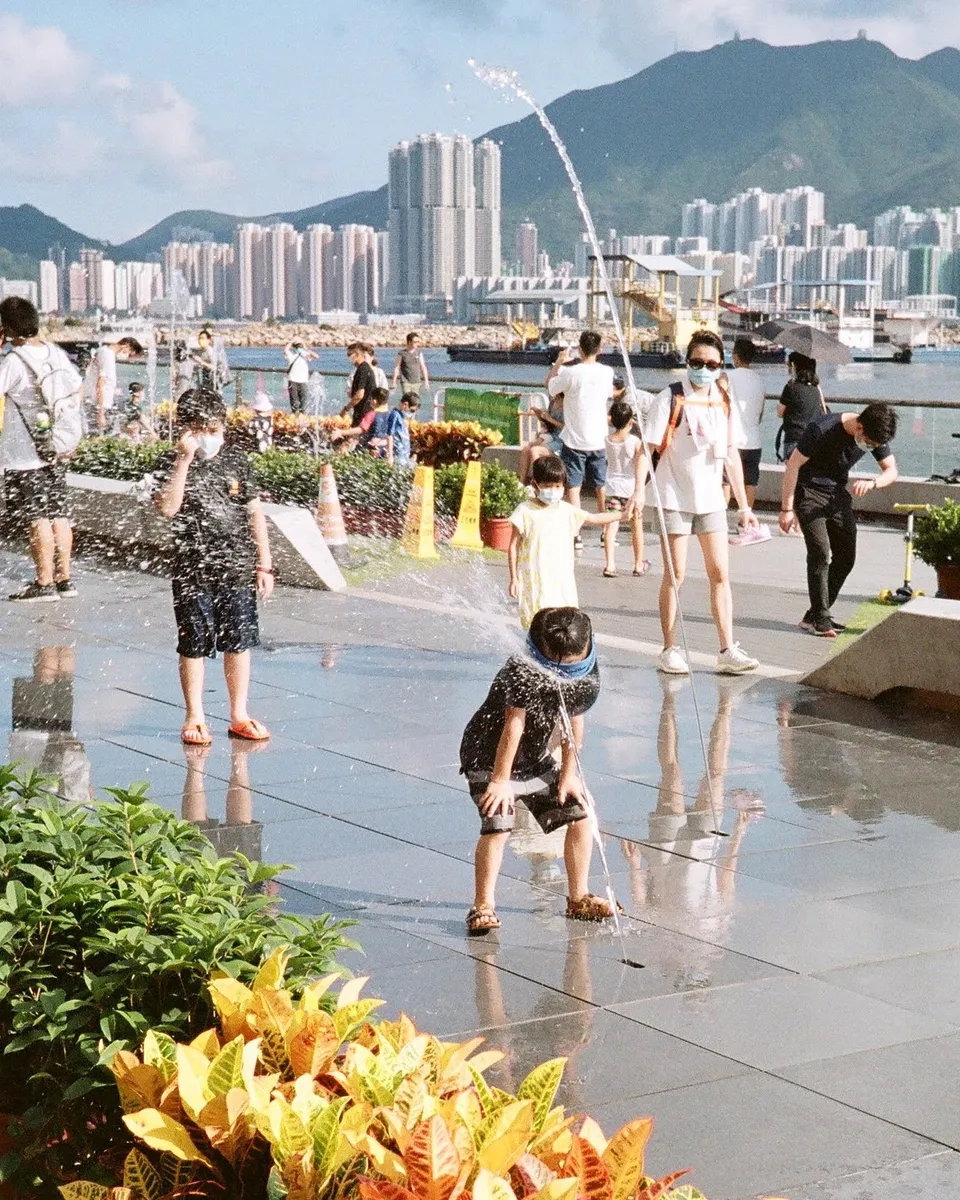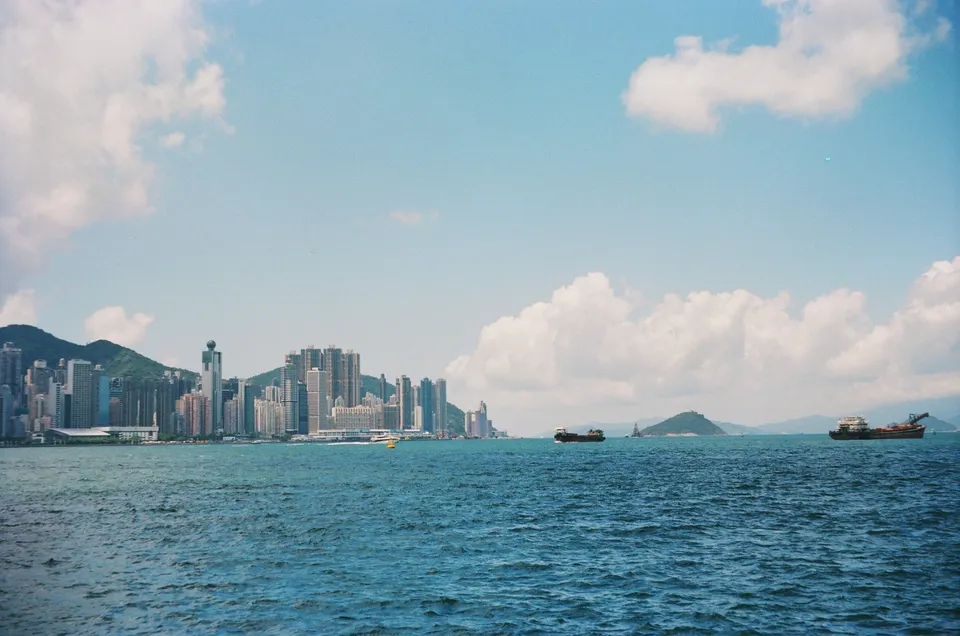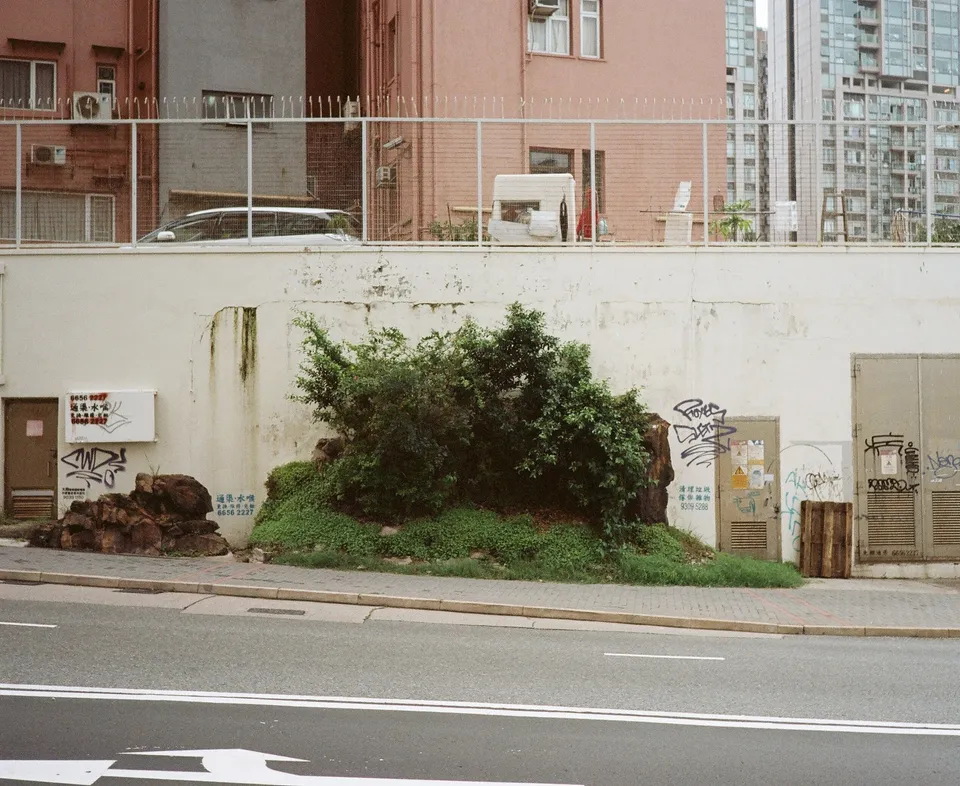IG Monthly Best - June 2021
Interfuit (that-has-been), Freedom, Air-Conditioning, and A Certain Death

Forgot to bring a model but there are plenty around
This year I bought a couple of Kodak Portra 160 that's expiring on July. Because they are expensive, I had never quite feel like using them until the point they are soon expiring. Having set the ISO to 100 on my Agfa Optima 1535 as opposed to the box speed slightly overexposse the shots, keeping shadow content and hopefully not blowing out highlight too much. I had no idea how it would turn out for this is my first time overexposing Portra 160. Fortunately it went quite well. In a low-light situation like this, even the low-light area near the bottom left corner is clearly visible, so the shot can appear in good balance and harmony.
This photo was taken in Jimmy bridge near where I work. Because of its unique shape and color scheme it attracted many to visit, and sit on the easily accessible openings for posing. The day when my firend and I visited the bridge, we agreed that the bridge itself is nice, yet not good enough to produce a surprising photo. At the time, there were two other photographer photographing a well-decorated model. And then there were several couples and groups around as well. There was no shortage of subjects, and this photo is the result of the fact.
After having been on the street for so long, I came to realize that if the photographer keep a distance and use a low-profile camera (compact rangefinder as opposed to DSLR with a long lens), people are quite receptive of being photographed. They may not pose for you. They may turn away. But they won't be upset about you photographing them. This thus allowed me to capture the interfuit of their being, the truth where the subjects were there, and posed as such, an instant which was immediately separated for infinity.

Reverse waterboarding
On the same day after the Jimmy bridge photo, we walked along the Kwun Tong Promenade under the scorching sun to see the recently opened music fountain. I was slightly worried about overexposing Portra under direct sunlight. All the photos, however, turned out very well. Actually, the water splashes wouldn't have been more spectacular without a slightly slower shutter speed induced by low the ISO setting.
The underwhelming music fountain costing the tax-payers HK$50M has no music during the day. Instead, the laughers of the kids had became the music so long as there's a constant supply of water. (Oh, and also sound of the guard warning people not to jump into the pool.) At a fixed time interval, streams of water would rush out from holes on the ground, and the kids have all sort of fun blocking, diverting or catching the water. Hilarious moments like this were very common, ugh, especially with this kid and the one in black behind.
This whole scene is shouting "Freedom" at me. As my age and responsibility grew, it had became harder and harder to conceive of or perform a "surprising move", as rational mind would have turned down the thought of doing the extraordinary, for perhaps fear of losing face or damaging a reputation. What I could do in the past, now I cannot. Isn't it a loss of freedom? How much did I give up, gradually over time, to become like this. Using work, professionalism or an anyway unpredictable prospect as excuses to deny the present, and in turn, losing everything.

You OT not me
Having shot only two rolls of Portra 160, the amount of pleasant surprises I get from the shots had been, well, surprising as opposed to the budget film stock ColorPlus 200 or Fuji C200. Perhaps Portra just have a thing with blue skies, and un-ugliness at more general situations. The lower part, frontground of this image—waves and ships and buildings can be viewed in isolation and to be a fully contained pleasure. And the sky, where highlight is usually blown out, backs this up with a general gradient of blue. I guess that's the reason why this photo is so attractive to me too.
This shot was taken at West Kowloon Cultural District looking out at the western part of Hong Kong Island during a photowalk with my friend. Since I have so many photographic gear, I decided to bring along my Agfa Solina with Color-Apotar lens which is a simple viewfinder camera, focusing is done by guess the distance between photographer and the subject, then turn the focusing ring to the correct marked position. On a street photography setting, this encourages pre-focusing, and there a bright sunny day is the best setting for that. With a fairly small aperture (f/8-f/11) I was able to set the focus at 3-10 meters and have everything properly in focus. All I had to do is to aim and shoot, as opposed to unconsciously double or triple checking the focus before taking a shot on rangefinder cameras.
Even on a hot sunny day, there were many people in the park. Many of them came with families and pets. There was a group of kindergarten, all dressed up in uniform and I had no idea what they were doing. My companion and I were lazy, we walked around the park then quickly retreated into an air-conditioned cafe, had an expensive lunch—which we accepted as the cost to air-conditioning. Another happy photowalk.

The old man walked away, maybe reluctantly maybe not. How'd I have known he wanted to be photographed
Portra 160 again. I have shot 2 rolls of Portra and 1 roll of Vision3 250D in the past two months and I would say Portra produces more pleasant surprises where the photos turn out better than originally anticipated. Well, 250D is a motion picture film where the emphasis is not on out-of-the-box output, but the latitude and reduced grain for post-production. This Portra 160 shot, however, has that hint of a 250D shot with its muted colors and the slighly yellow-ish tint.
Nevertheless, the photographic property of this shot is not the reason of it becoming my personal favorite of the month.
This photo of a rock sticking out from the side of a building was taken on another photowalk from Mong Kok to Whampoa, just before Ho Man Tin. The contrast of a natural-looking rocks next to an artificual structure interested me. Across the road I raised my Optima 1535, patiently waiting for the vehicles on the road to pass by through the viewfinder.
Around the same time, an old hunchback man with his walking stick stopped in front of the rock, turning his head to face me and my camera. I have had bad experience on the street when people get upset about me photographing them, so I reflexively thought this is one of those cases. I waved to him, across the road, while speaking "no, I am not photographing you". He walked to the left side and stopped at the gap between the green and brown rock, and stood there turning to face me again. I signalled again, "my frame is here, you should walk further away" and so he did, yet stopping only a few steps beyond the brown rock. I took the shot without him in the frame, then walked away.
In hindsight, why would someone who doesn't want to be photographed stop in front of the rock and stayed in the frame? Oh my. I seeked explanation from my companion, and he concluded the same. The person wouldn't have been upset about me photographing him, otherwise he'd have walked away with haste or begin shouting at me.
Such is a punctum in Roland Barthes's language, I would say, except that it's not what within the frame that 'pricks' me as a spectator, but the context around the frame, the history of it. What pricks me perhaps is that the story itself is nowhere to be found, yet it 'saves' the old man from a certain death.
We pass by strangers every day. The moment after they pass, it no longer matters to us whether they live or they die. They could have died shortly after, or out-live oursevles. Yet their existence (or inexistence), from our egoistic view, would have became meaningless. The existence of such a person, becomes an interfuit with this photo and this account.
And to somewhat, maybe, possibly land this on a high note, it gives us a the agency to save someone from their perceived death by means of photography. Or if need be, to 'create' a 'death' (non-material death, of course) by simply destoying the medium—the film and prints.
